Exercises (2256)
Basketball/streetball: passing relay with a basket shot as a finale
Forms of play / exercises
Group work
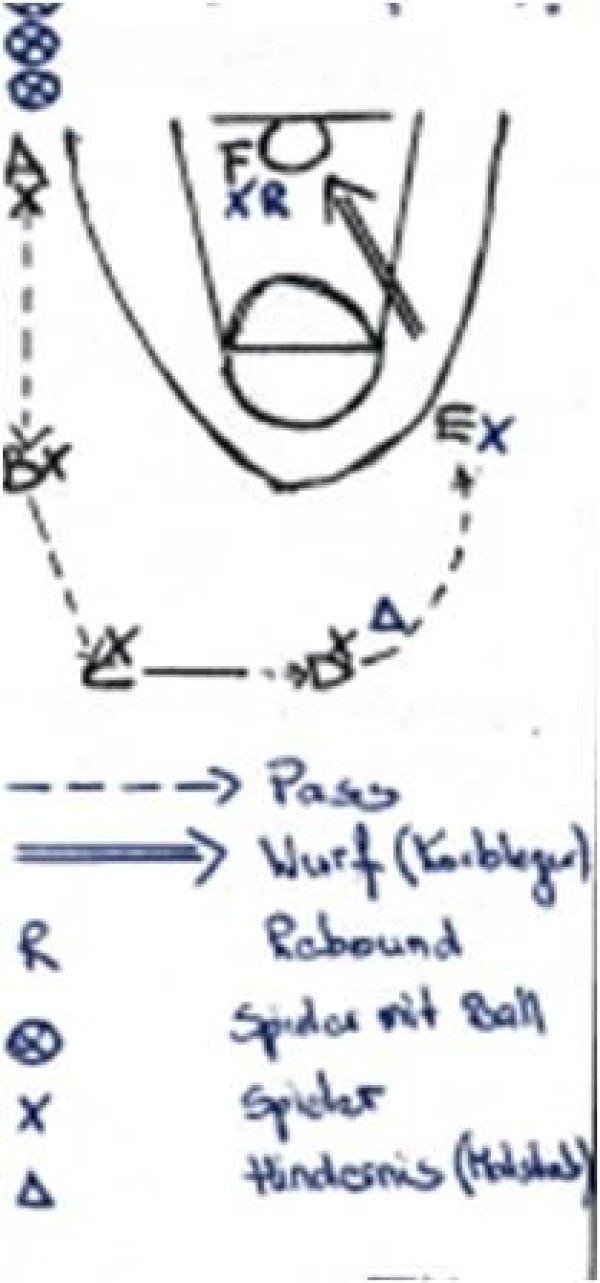
The participants pass the ball to each other in the specified form before the last player in the line puts the ball in the basket with a lay-up.
Passing sequence:
1. A-B Overhead pass
2. B-C Chest pass
3. C-D Floor pass
4. D-E Lateral curve pass (i.e. pass next to the body; with one or both hands)
5.i.e. pass next to the body; one- or two-handed)
5. E Finish with a lay-up
6. F Secure the ball, then line up with the ball in the column
7. A-F Move to the next position in order immediately after the action
Per participant:
1 basketball
5 colouring sticks
Basketball/Streetball: Rebound
Forms of play / exercises
2 teams of 3-4 players each

Basketball game with 2 teams (3-4 players each) on one half of the court. Aim for the basket and two additional hoops. An oversized ball, e.g. a gym ball, is placed on the basketball hoop. 2 points can be scored if the basketball bouncing off the gym ball is caught as a rebound. 1 point is scored if the ball is placed in a hoop. This can be prevented by a defender putting his foot in the hoop. The attacker is the referee.
Objectives: Use of the rebound, opening up the game through additional scoring opportunities.
Variant I:
Change of possession after a point or when the ball is lost.
Variant II:
One team tries to score as many points as possible during 1-3 minutes and counts the points.
1 basketball
1 basketball hoop
1 gym ball
2 hoops
x game wristbands / covers ►team identification
Basketball/streetball: Snapball
Forms of play / exercises
2 teams of 4-7 players each
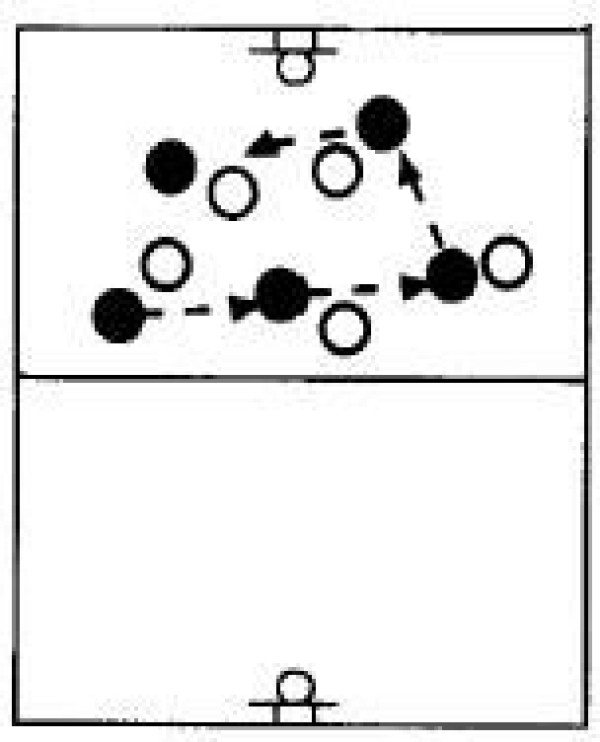
Two teams of 4-7 players play against each other in one half of the court. The team in possession of the ball tries to reach 10 catch points by passing, the passes are counted out loud. The 10th catch point authorises a fast attack on the basket in the free half of the court. The other team gains the right to a quick attack by winning the ball.
Objective: Adapted tactics, quick changeover from attack to defence.
1 basketball
2 basketball hoops
x game wristbands / covers ►team identification
Basketball/Streetball: Throw from the box
Forms of play / exercises
2 Teams

Each player on both teams is given a number. The player with the number 1 stands on the box, only he can score a valid basket. The box and its territory are off-limits to the defence. After a successful basket shot, the number 2 climbs onto the box, number 1 becomes a field player.
Objective: Time for undisturbed basket shot, take position for rebound.
1 basketball
1 Swedish box
x game wristbands / cover ► team identification
Prone position
Coordination exercises
Individual work
Prone position on the slackline. Ideally, the slackline runs diagonally under the body (e.g. right shoulder, left thigh and left shin rest on the line).
Lighten the load:
Hold on to the slackline with one hand.
Lighten the load:
Stretch your arms out to the side; stand up from a prone position.
1 Slackline
Prone position and upright position alternating ► db burpee deadlift
Power
Individual work
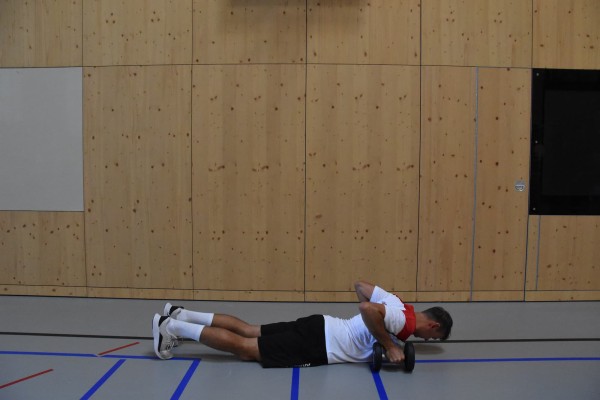
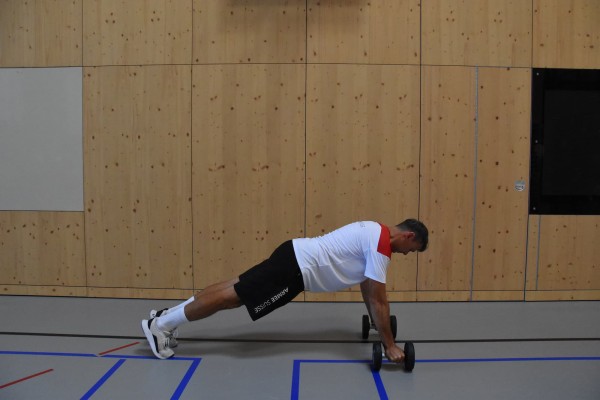
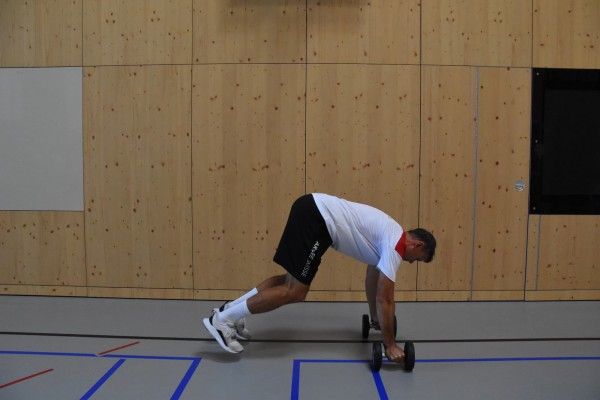
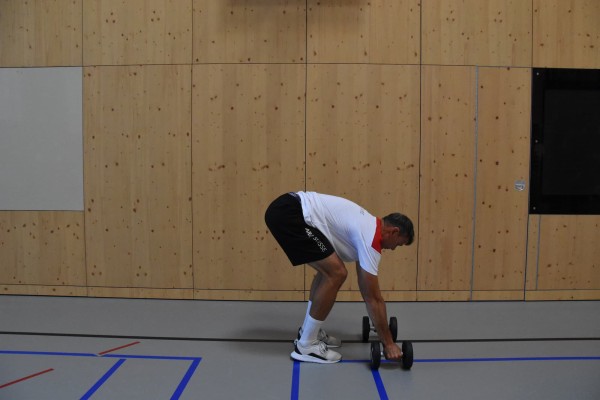
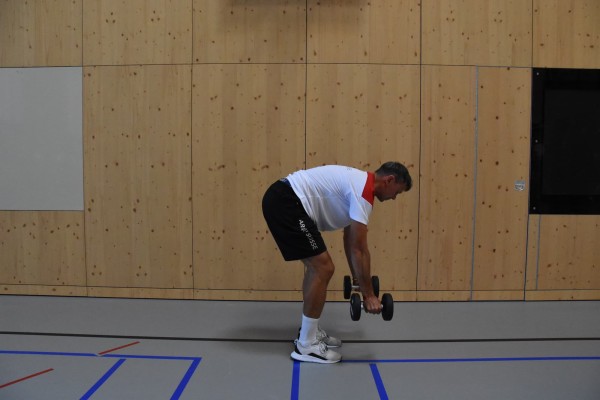
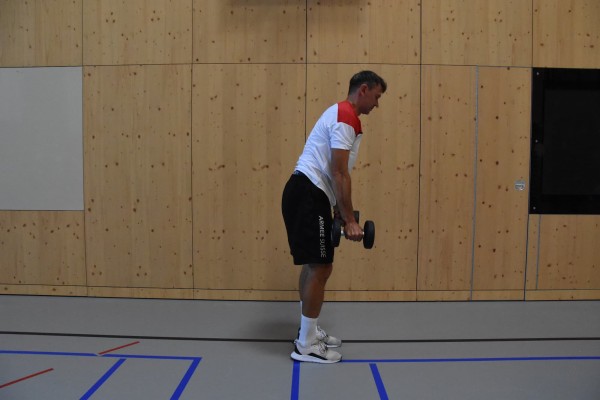
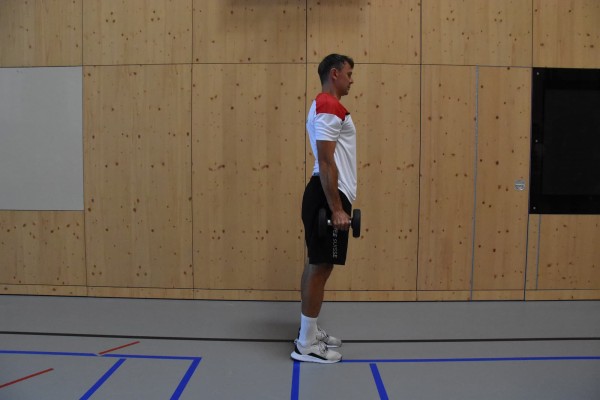
Stomach position, grasp a dumbbell with both hands (back of each hand pointing to the respective side), these are placed on the floor at chest height, the arms are bent accordingly. From this position, stretch your arms to push your upper body away from the floor, your knees are also no longer in contact with the floor and your slightly bent legs are only supported on the tips of your feet. With a small jump forwards, bring your legs approximately shoulder-width apart towards the dumbbells (place your feet slightly inwards behind the dumbbells on each side). The upper body is tilted forwards as the outstretched arms are still holding the weights on the floor (back as straight as possible). Now straighten your legs, push your hips forwards and raise your upper body to a standing position. The arms remain stretched and point sideways along the body towards the floor in the end position so that the weights are approximately at hip height. Then lower your upper body back down to place the weights on the floor again with your arms straight (with the tips of your feet slightly offset outwards). Support your upper body with your arms (hands gripping the dumbbells) to perform a two-legged jump backwards so that you reach the push-up position. Lower your upper body back to the starting position in the prone position (bend your arms, hold the weights next to your chest, knees on the floor, straight legs resting on the tips of your feet).
Lighten:
Less/no weight.
Harden:
Execute a push-up instead of lowering your body to the prone position; more weight.
2 dumbbells
Prone position and upright standing alternating with extension and flexion of the arms ► burpee & snatch / devil press
Power
Individual work
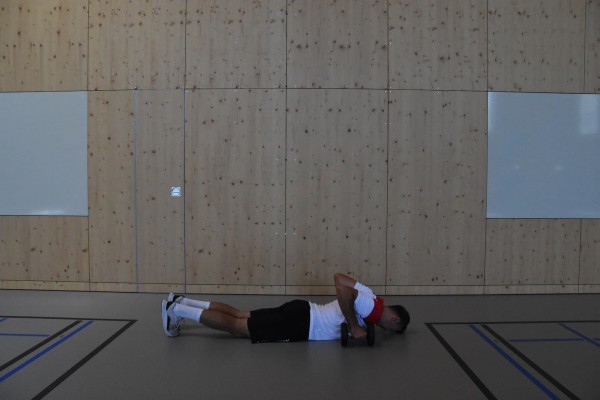

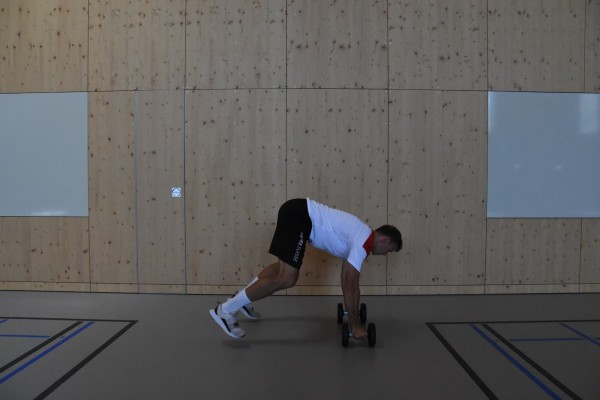
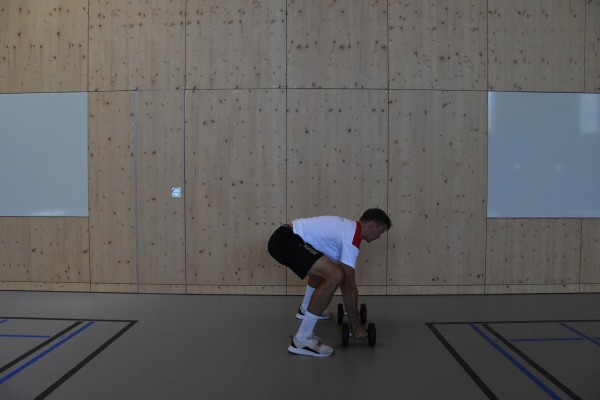
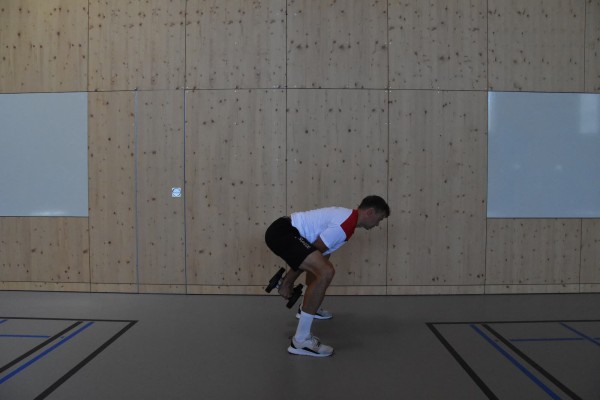
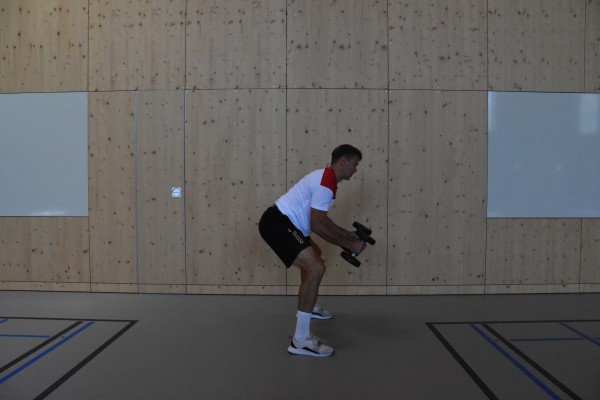
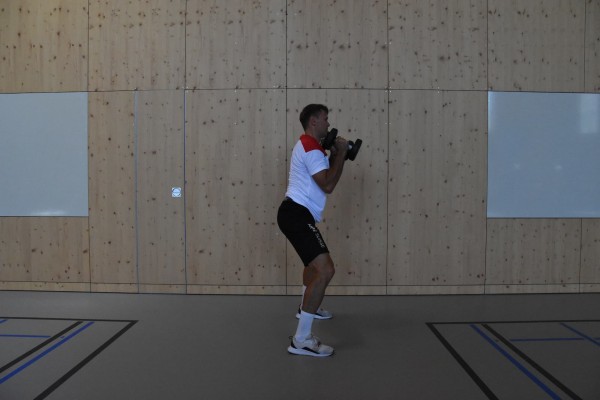
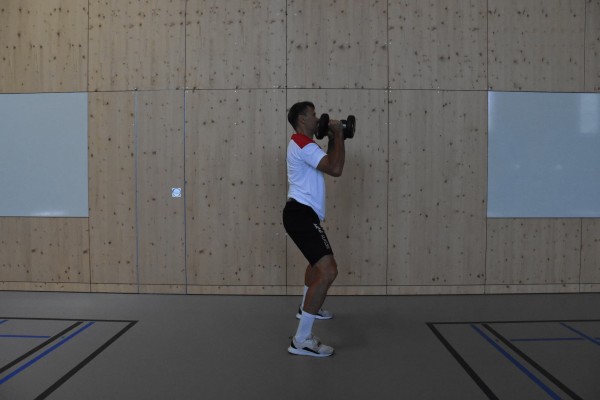

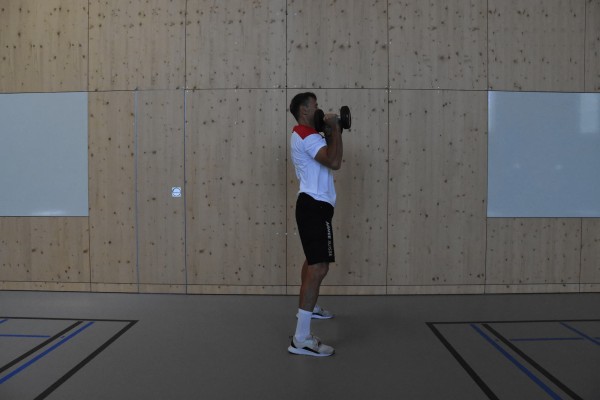
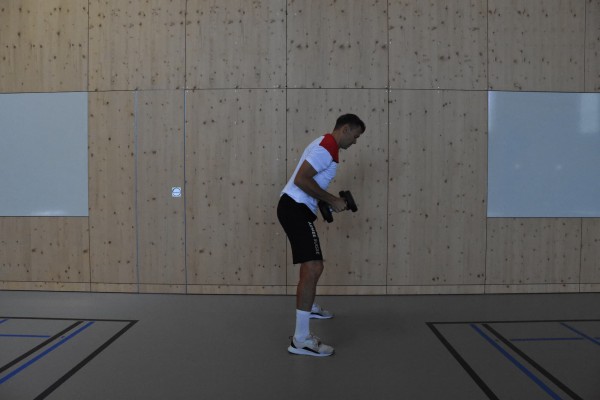
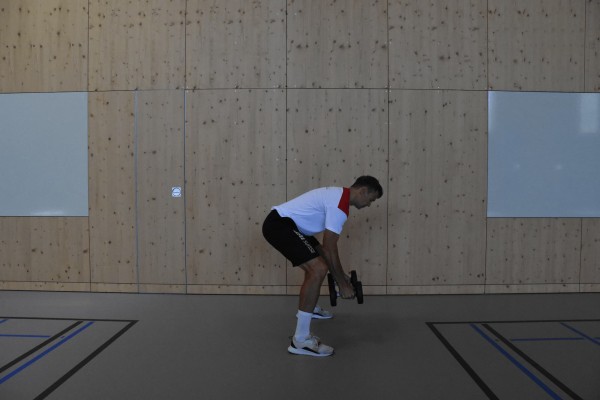
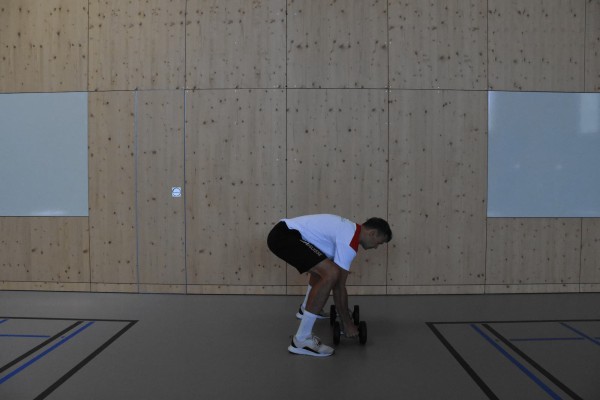
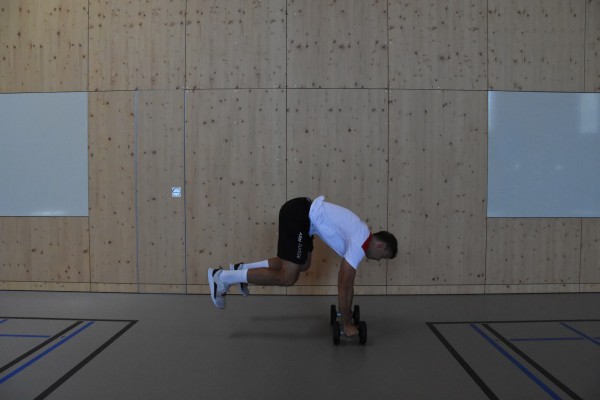

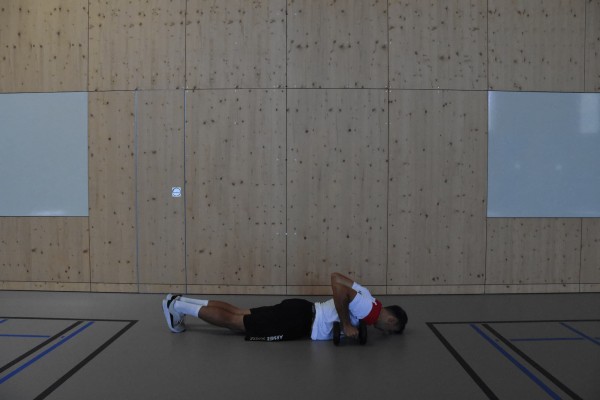
Stomach position, grasp a dumbbell with both hands (back of each hand pointing to the respective side), these are placed on the floor at chest height, the arms are bent accordingly. From this position, stretch your arms to push your upper body away from the floor, your knees are also no longer in contact with the floor and your slightly bent legs are only supported on the tips of your feet (push-up position). With a small jump forwards, bring your legs more than shoulder-width apart towards the dumbbells (place your feet slightly outwards behind the dumbbells on each side). The upper body is tilted forwards as the outstretched arms are still holding the weights on the floor (back as straight as possible). Now lift the weights off the floor and move them backwards between your legs to the height of your buttocks with your arms stretched out. Now swing the weights overhead by first holding the dumbbells in front of your chest with your arms bent, and from there push your arms out vertically upwards. The upright stance with arms stretched upwards and legs slightly bent corresponds to the end position. Then bend your arms while standing upright to bring the weights to your shoulders. Tilt your upper body forwards, stretch your arms and place the dumbbells on the floor between your legs (slightly in front of your feet) (legs slightly bent). Support your upper body with your arms (hands gripping the dumbbells), jump backwards with both legs so that you can assume the starting position in the prone position in one smooth movement (bend your arms, lower your upper body, hold the weights next to your chest, knees on the floor, straight legs resting on the tips of your feet).
Lighten:
Less/no weight.
Harden:
Execute a push-up instead of lowering the body to the prone position; more weight.
2 dumbbells
Prone position and alternating handstand ► wall walk
Power
Individual work
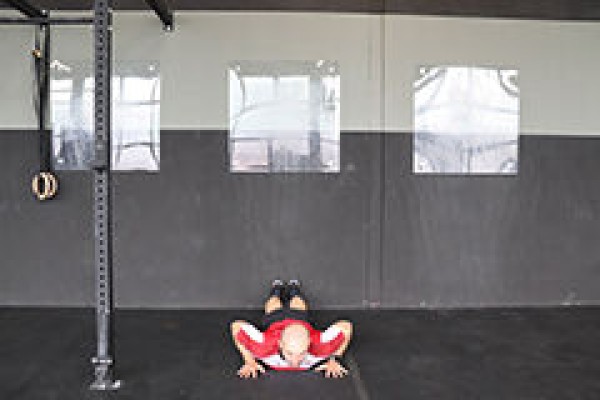
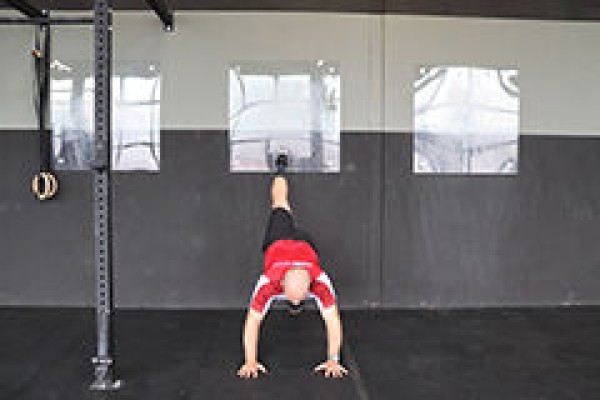
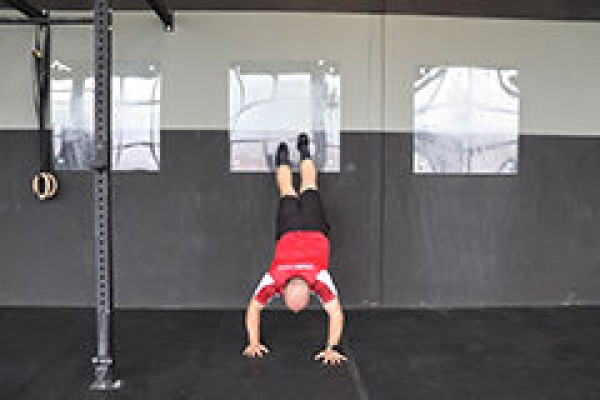


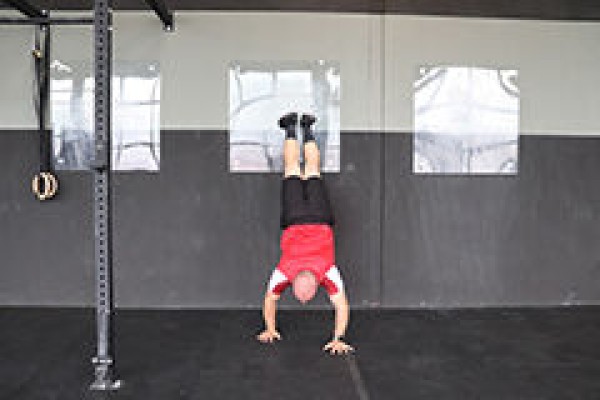
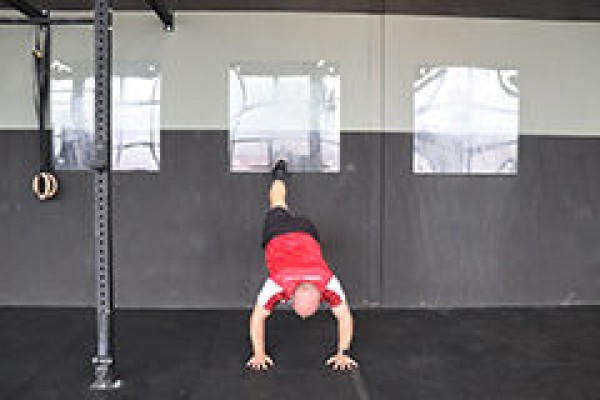
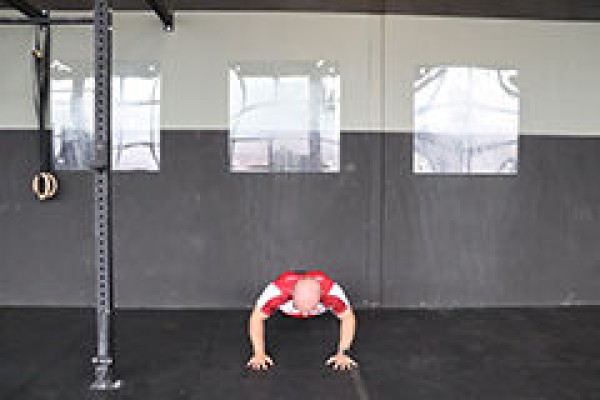
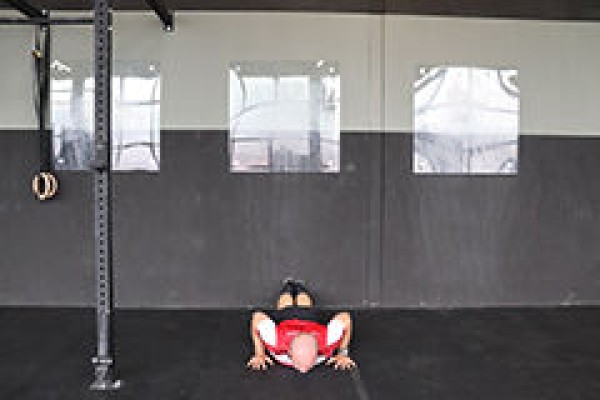
Lie on your stomach in front of a wall with the tips of your feet exactly in the corner between the floor and the wall and your arms bent next to your shoulders (palms on the floor, elbows pointing towards the wall). Extend your arms to push your upper body away from the floor, then walk your feet upwards along the wall (alternately moving one leg upwards), at the same time as moving your legs upwards, alternately move your arms towards the wall (walking with your arms). The legs and arms are moved until the handstand position can be assumed (full body stretch, arms stretched out in a high position). Then perform the movement sequence in reverse order to return from the handstand to the prone position.
Attention:
Move your legs and arms in a controlled manner.
Lighten:
Break off the exercise before the handstand position and return to the prone position (move your legs less far upwards).
Harden:
Additional weight (on your feet).
1 wall
2 weight cuffs/1 weight waistcoat ► make the exercise more difficult (additional weight)
Prone position and handstand with sideways shift alternating ► lateral wall walk
Power
Individual work
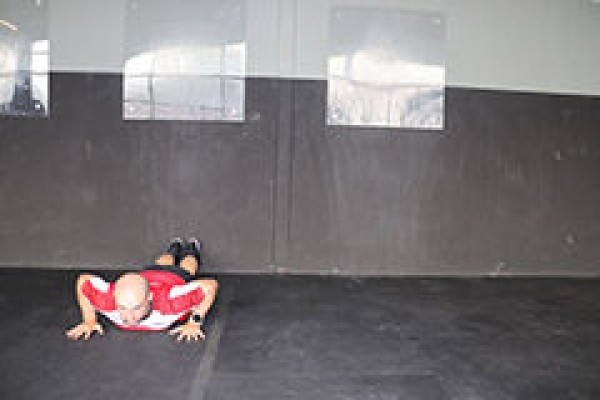
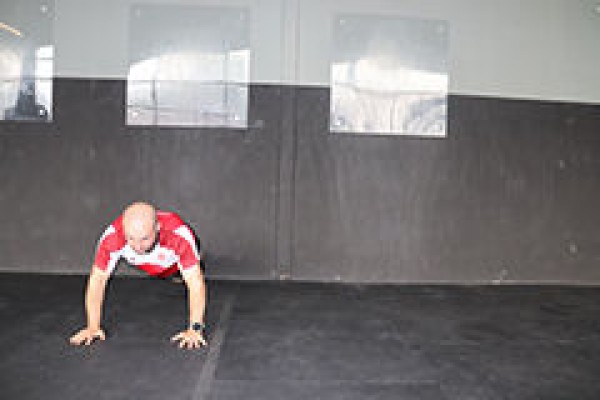
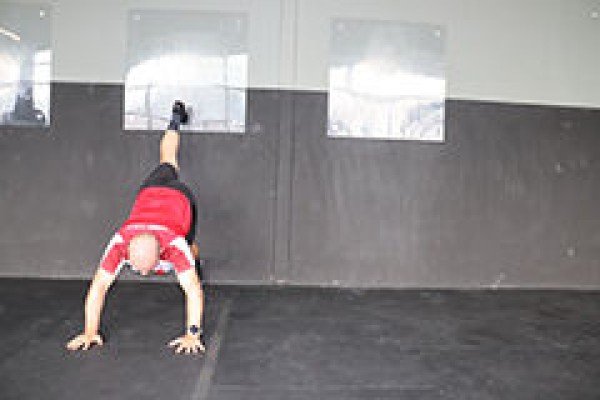
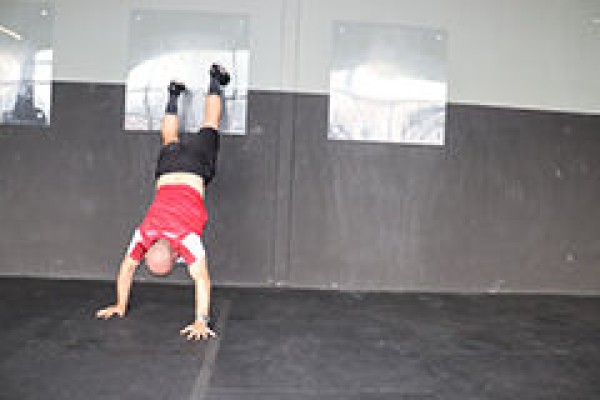
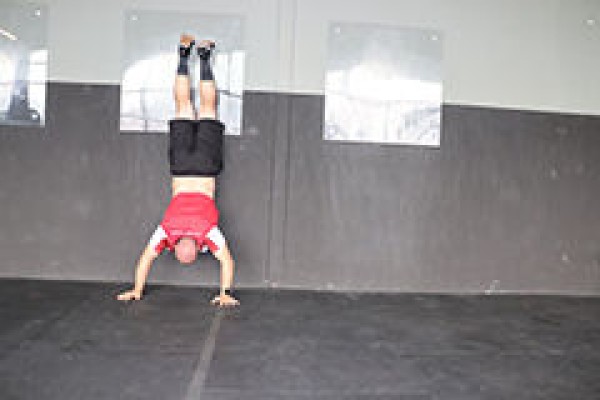
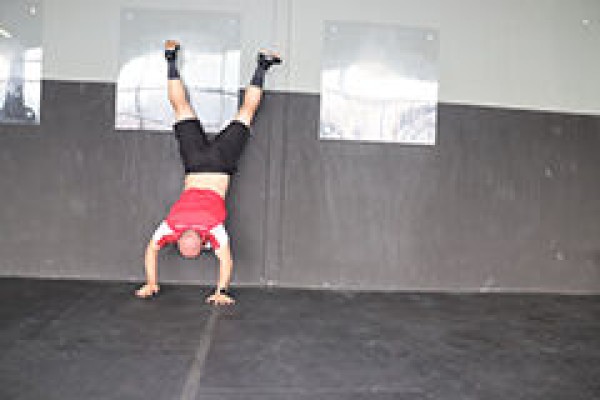

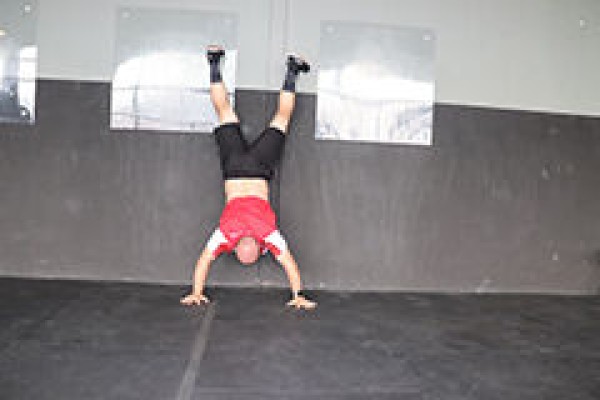

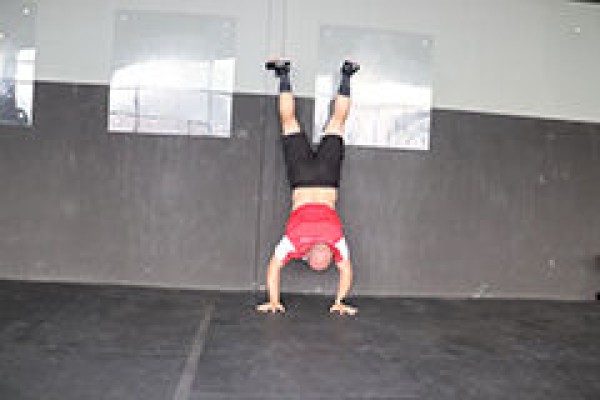
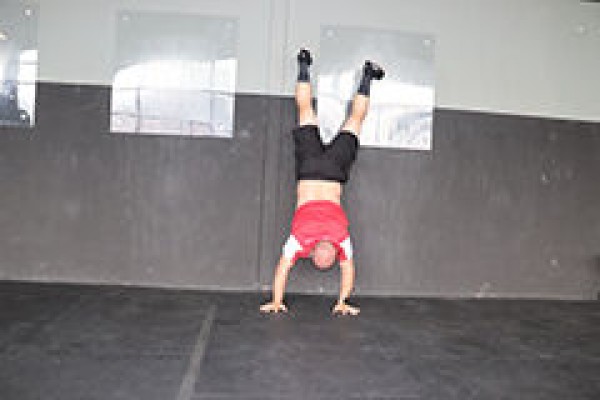
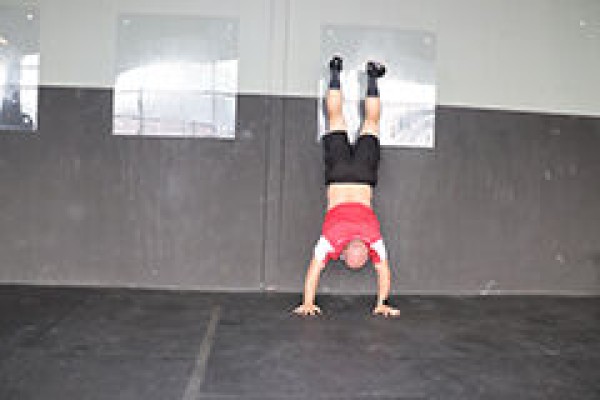
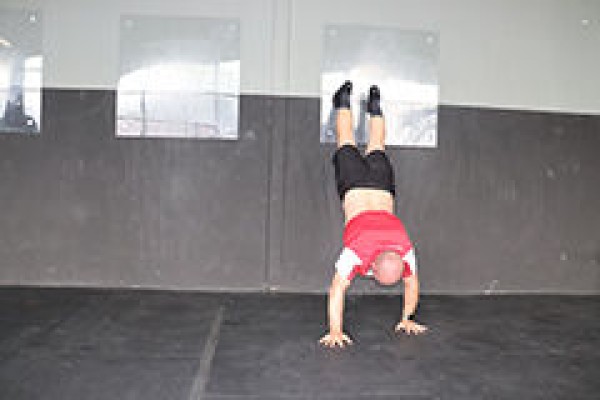
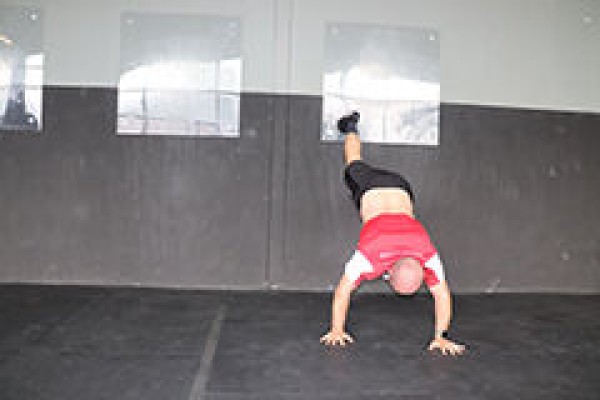
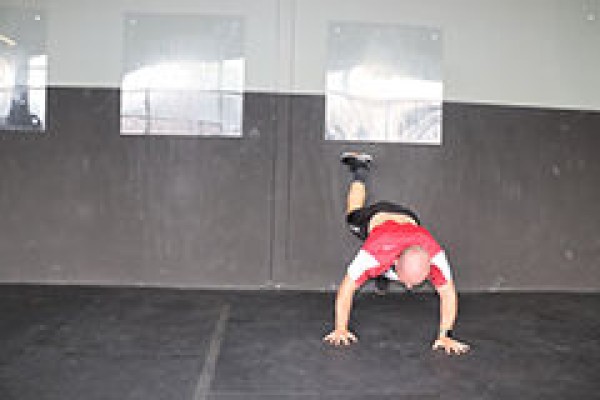
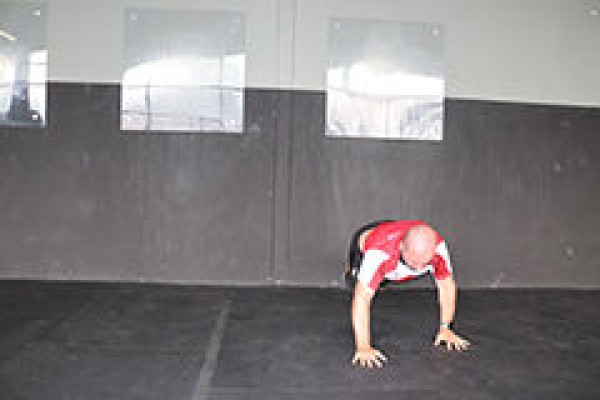
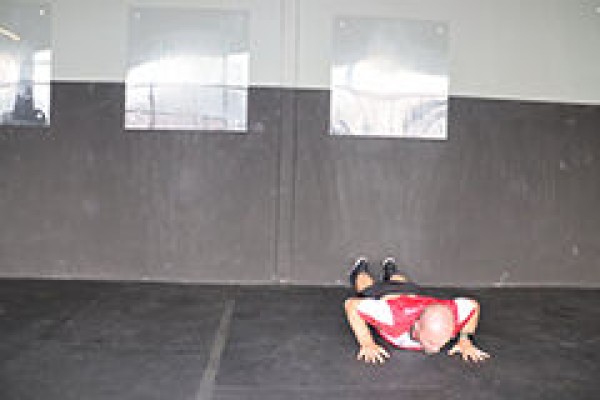
Lie on your stomach in front of a wall with the tips of your feet exactly in the corner between the floor and the wall and your arms bent next to your shoulders (palms on the floor, elbows pointing towards the wall). Stretch your arms to push your upper body away from the floor, then walk your feet upwards along the wall (alternately moving one leg upwards), at the same time as lifting your legs, alternately move your arms towards the wall (walking with your arms). The legs and arms are moved until the handstand position can be assumed (full body stretch, arms stretched in a high position). Once in the handstand position, the hands are moved to the side a few times (running sideways with the hands) before the sequence of movements is repeated in reverse order to return from the handstand to the prone position. For the next repetition, move your arms to the other side to return to the starting point of the exercise.
Attention:
Move your legs and arms in a controlled manner.
Lighten:
Stop the exercise before the handstand position and return to the prone position (move your legs less far upwards); perform the exercise without moving your arms.
Harden:
Additional weight (on your feet).
1 wall
2 weight cuffs/1 weight waistcoat ► make the exercise more difficult (additional weight)
Encounter run
Basic training
Partner work
Groups of 2 (integrate new group formations)
Two participants run on a circuit (e.g. athletics track) starting from the same point in the opposite direction. As soon as they meet, they run the same route back again. The aim is for both to arrive back at the starting point at the same time. The exercise form is continued until it is cancelled by the training leader.
Track: circuit
Intensity level: 3 (medium)
Max HR: 80-90%
Rule of speech: speak in complete sentences
Variant:
The participants run at different speeds (e.g. participant A: intensity 3; participant B: intensity 2).
Participant:
1 heart rate monitor
Move leg backwards and back in standing position (left) ► kick-back
Power
Individual work
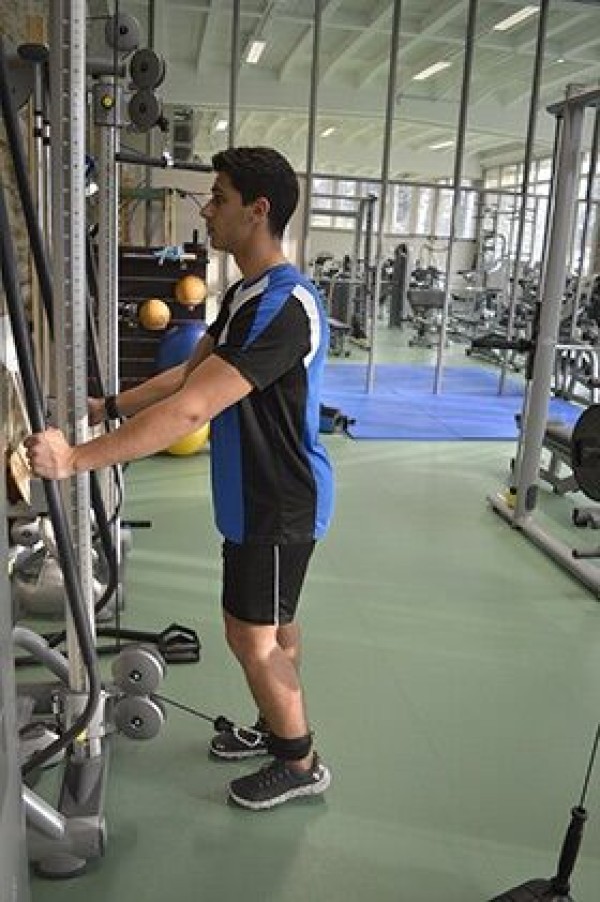
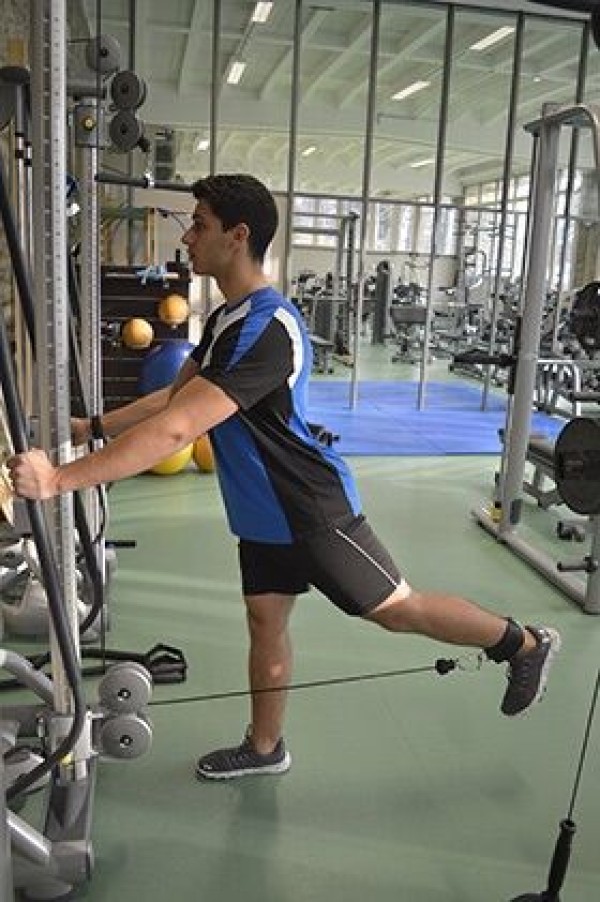
The foot loop of the cable pulley is placed around the training leg (left). In a standing position, facing the cable pulley, the leg is slowly pulled backwards against the weight and returned to the starting position in a controlled manner.
Starting position:
- Stand upright in front of the machine
- Hands on the machine to maintain balance
- Foot loop fixed to the ankle
Finishing position:
- Leg pushed backwards
- Movement from the hip, angle in the knee remains the same
Attention:
Training leg not fully extended.
1 weight tower/machine ► cable pulley (deep)
Move leg backwards and back while standing (right) ► kick-back
Power
Individual work
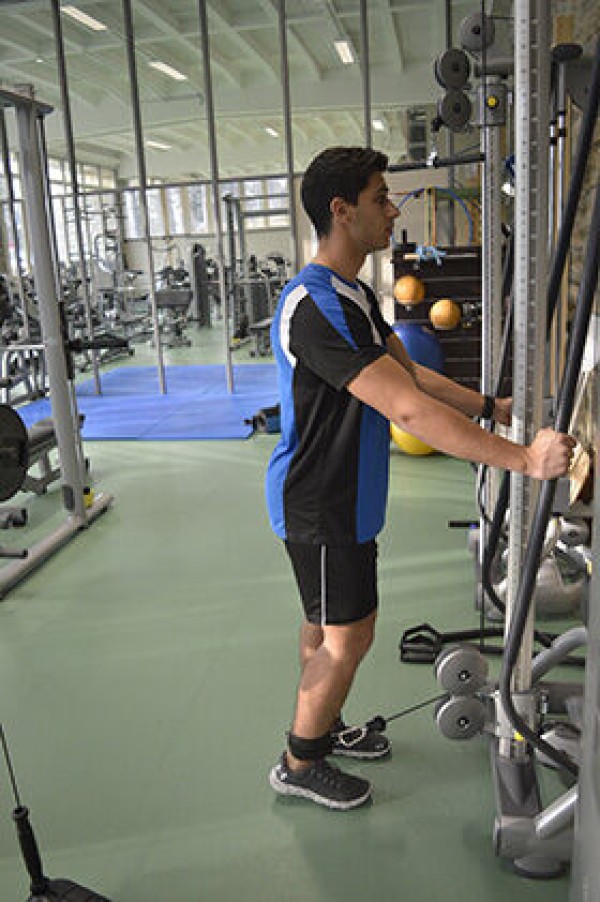
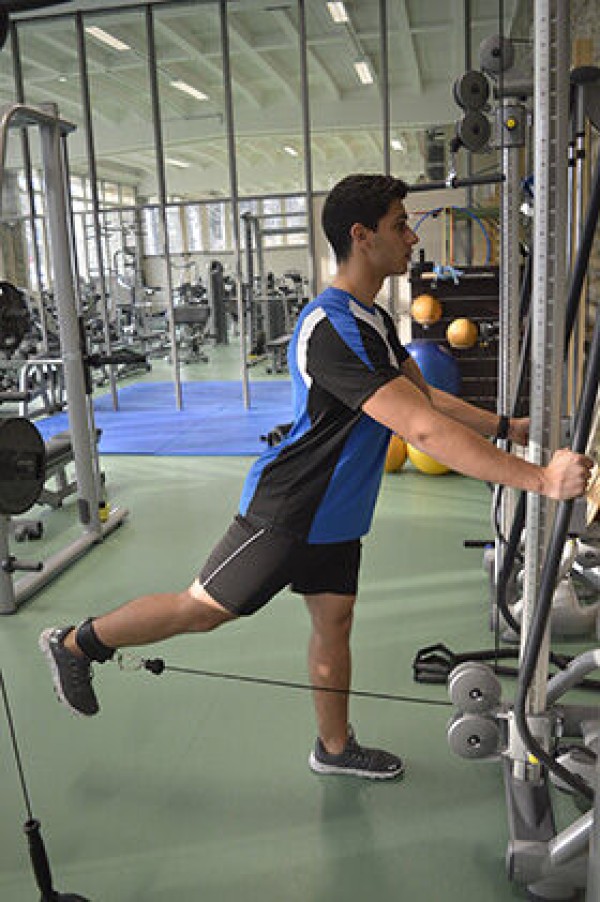
The foot loop of the cable pulley is placed around the training leg (right). In a standing position, facing the cable pulley, the leg is slowly pulled backwards against the weight and returned to the starting position in a controlled manner.
Starting position:
- Stand upright in front of the machine
- Hands on the machine to maintain balance
- Foot loop fixed to the ankle
Finishing position:
- Leg pushed backwards
- Movement from the hips, angle in the knee remains the same
Attention:
Training leg not fully extended.
1 weight tower/machine ► cable pulley (deep)
Push your leg out forwards while standing ► front kick
Power
Individual work
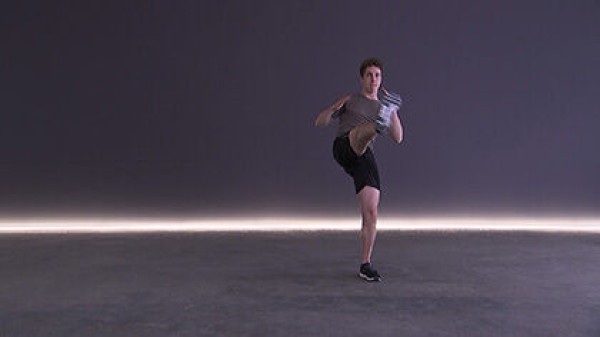

Stand shoulder-width apart, one leg slightly backwards (weaker hand/weaker leg in front), gaze/face forward, upper body slightly rotated (to the side of the stronger leg), arms bent in front of the body, lift one leg alternately or in free rhythm and push off in the direction of gaze (push off/kick movement forwards).
Attention:
Do not fall backwards with your upper body when kicking your leg out.
Lighten:
Kick your leg out less high.
Harden:
Push your leg out higher; add weight to your leg.
Variant:
Load one leg for longer by not putting it down completely (or only supporting it slightly on your toes).
2 weight cuffs ► make the exercise more difficult (additional weight)
Push your leg out forwards in a standing position and lunge backwards alternately (left) ► front kick & reverse lunge
Power
Individual work
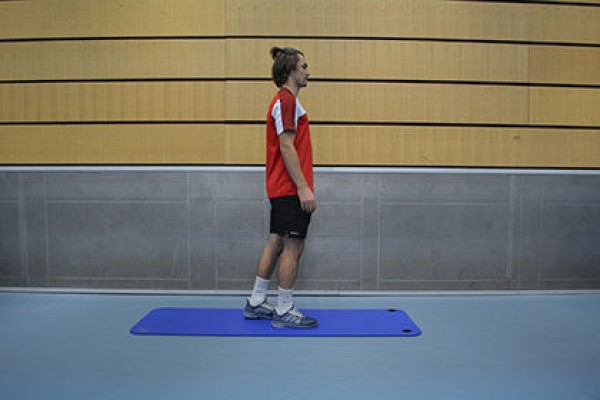
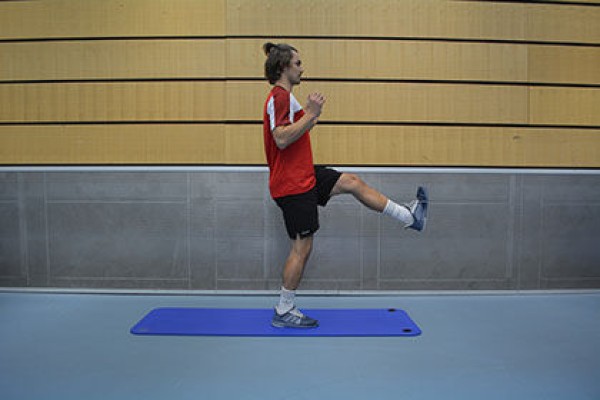
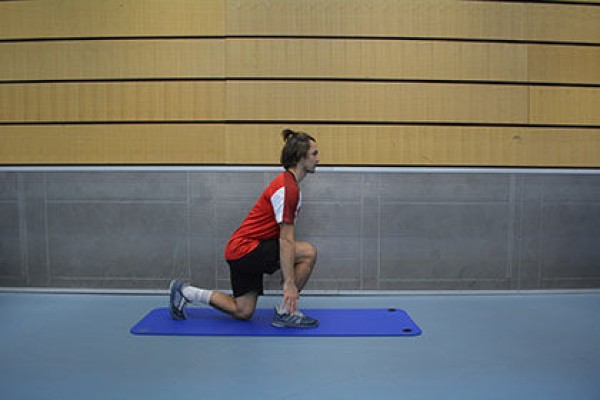
Stand shoulder-width apart, one leg (left) slightly backwards, gaze/face and upper body facing forwards, arms hanging beside the body. Raise one leg (left) and kick it out in the direction of your gaze (kick movement forwards), bend your arms at the same time and move your hands to head height. Lower your upper body as you bring your free leg back, bend your supporting leg and bring your free leg backwards, both hands touching the floor (lunge position - similar to starting a sprint). Alternate between the two positions (kick forwards and lunge backwards) with a high cadence.
Attention:
Do not fall backwards with your upper body when kicking your leg away. Keep your posture upright when lunging.
Lighten:
Push your leg out less high or far back.
Harden:
Push your leg out higher; add weight to your leg.
1 weight cuff ► make the exercise more difficult (additional weight)
Push your leg out forwards in a standing position and lunge backwards alternately (right) ► front kick & reverse lunge
Power
Individual work
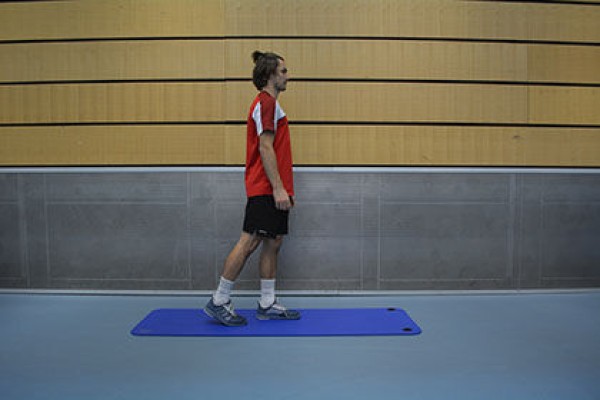
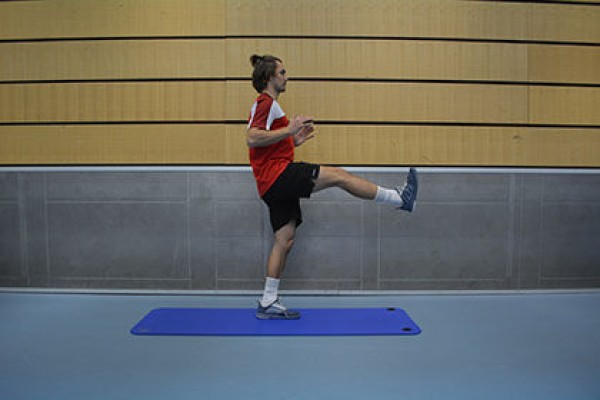
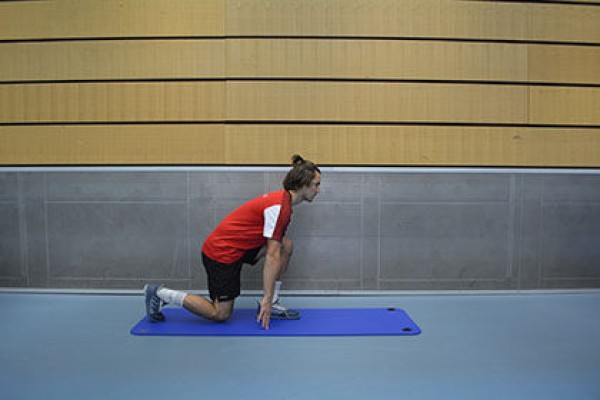
Stand shoulder-width apart, one leg (right) slightly backwards, gaze/face and upper body facing forwards, arms hanging beside the body. Raise one leg (right) and kick it out in the direction of your gaze (kick movement forwards), bend your arms at the same time and move your hands to head height. Lower your upper body as you bring your free leg back, bend your supporting leg and bring your free leg backwards, both hands touching the floor (lunge position - similar to starting a sprint). Alternate between the two positions (kick forwards and lunge backwards) with a high cadence.
Attention:
Do not fall backwards with your upper body when kicking your leg away. Keep your posture upright when lunging.
Lighten:
Push your leg out less high or far back.
Harden:
Push your leg out higher; add weight to your leg.
1 weight cuff ► make the exercise more difficult (additional weight)
Move leg forwards and backwards in shoulder position (left) ► glute bridge
Power
Individual work

Shoulder position, one leg (left) bent, the other stretched out or also bent but held high, arms flat on the floor at the side of the body, pelvis raised, bounce forwards and back to the starting position with the supporting leg (left) (touch down with the heel).
Attention:
Pelvis always remains raised, upper body only rests on the shoulders.
Lighten:
Just hold the position with your pelvis raised; move your standing leg less.
Harden:
Additional weight (on the hips).
Variation:
Remnant carpet/felt slipper/glider under the standing leg to glide forwards and backwards.
1 weight vest/weight disc/dumbbell/sandbag ► make the exercise more difficult (additional weight)
1 carpet remnant/felt slipper/glider ► variation of the exercise
Move leg forwards and back in shoulder position (right) ► glute bridge
Power
Individual work
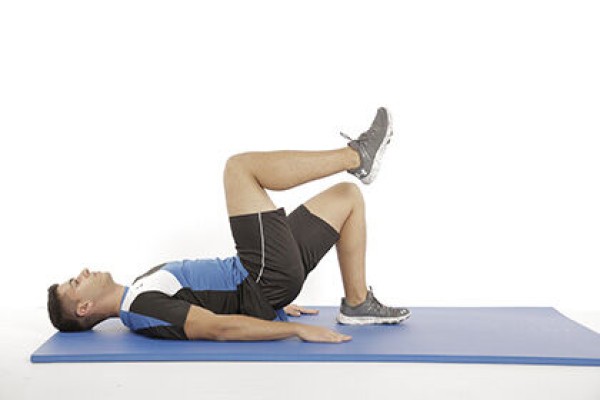
Shoulder position, one leg (right) bent, the other stretched out or also bent but held high, arms flat on the floor at the side of the body, pelvis raised, bounce forwards and back to the starting position with the supporting leg (right) (touch down with the heel).
Attention:
Pelvis always remains raised, upper body only rests on the shoulders.
Lighten:
Just hold the position with your pelvis raised; move your standing leg less.
Harden:
Additional weight (on the hips).
Variation:
Remnant carpet/felt slipper/glider under the standing leg to glide forwards and backwards.
Footwork (locomotion)
Light-Contact
Individual work
The participants practise with commands and corrections from the instructor.
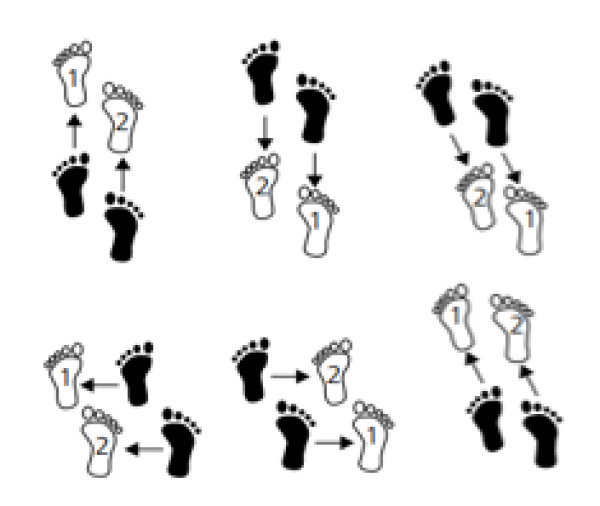
The movement is practised as follows:
The foot at the back in the direction of movement pushes off the floor and the foot at the front is placed 10-15cm in front. The rear foot is then pulled back so that the original starting position is restored. The movement is dynamic, gliding light-footedly over the floor. The movement can also be performed with small flat jumps. It is important to ensure that the movement is always practised in combination with the boxing position.
No material required
Footwork (sideways)
Light-Contact
Partner work


One participant circles the tyre with small readjusting steps, while the second participant tries to stay opposite. The participants take small flat (sideways) steps on the balls of their feet. The distance between the feet is not less than shoulder width. The foot closer to the direction of movement goes first, the second foot is only pulled up to shoulder width. Change roles after a while.
Per group:
1 tyre
Footwork (sideways)
Light-Contact
Partner work
The participants glide sideways from tyre to tyre in a boxing position. One participant leads and the other reacts accordingly and follows their partner.
8-12 tyres
Footwork and tackling
Light-Contact
Partner work
Moving from marker to marker (6 cones) in double cover, taking care not to cross your feet and keeping your legs shoulder-width apart. At the end of the course there is a short fight with the partner (first hit wins). The loser performs two quick squats. Both participants then start the movement exercise from the front (the two lanes are next to each other or opposite each other).
12 marking hats (6 per participant)
Participant:
1 pair of boxing gloves
Footwork: slalom
Light-Contact
Individual work
A slalom is run between stakes in double coverage (do not cross your feet but keep them shoulder-width apart).
Variant:
Competition form against another participant (optioanl: the slower one does 5 push-ups/torso bends/extension jumps).
7/14 stakes
Move your legs to the side while sitting alternately
Power
Individual work
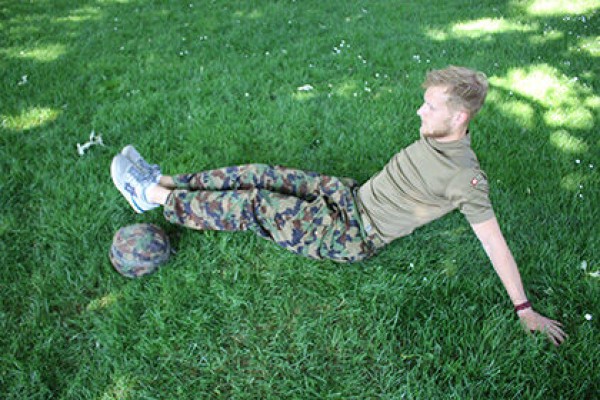

Sit on the floor, upper body slightly tilted backwards and supported by the hands, legs slightly raised from the floor in front of you and almost stretched out, alternately move the legs sideways over an object placed at foot level (e.g. helmet or rucksack), briefly tapping the floor with the heels on each side. Alternate legs sideways over an object (e.g. helmet or rucksack) placed at foot level, briefly touch the ground with your heels on each side.
Attention:
Do not put your feet down.
Lighten:
Legs bent more strongly.
Harden:
Legs extended; additional weight on/between the legs.
1 helmet/fighting rucksack
2 weight cuffs/1 PET bottle (1.5 litres)/ball/(additional) helmet/fighting rucksack ► make the exercise more difficult (additional weight)
Move your legs to the side while sitting alternately
Power
Individual work
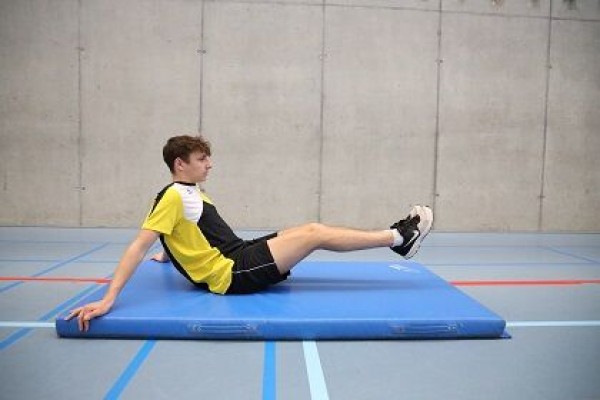
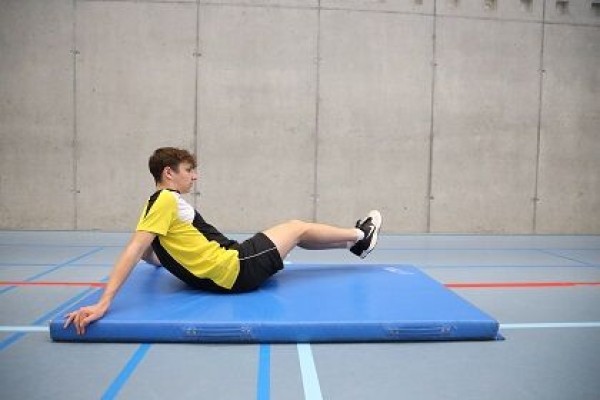

Sit on the floor, upper body tilted slightly backwards and supported by the hands, legs slightly raised from the floor in front of you and almost stretched out, alternate legs from one side to the other (optionally tap the floor briefly with your heels on each side).
Caution:
Do not put your feet down.
Lighten:
Bend your legs more.
Harden:
Legs stretched out; additional weight on/between the legs.
2 weight cuffs/1 (medicine) ball/weight disc/dumbbell ► make the exercise more difficult (additional weight)
Sequence of movements
Floor and apparatus gymnastics
The participants demonstrate a defined (or self-selected) sequence of movements to the sports leader (the group). The movements are practised by the participants beforehand.
Example of a possible combination:
- Forward roll
- Jump roll from standing position
- Stand balance
- Stretch jump with half turn
- Backward roll
- Handstand with roll-off
6-8 soft mats (small)